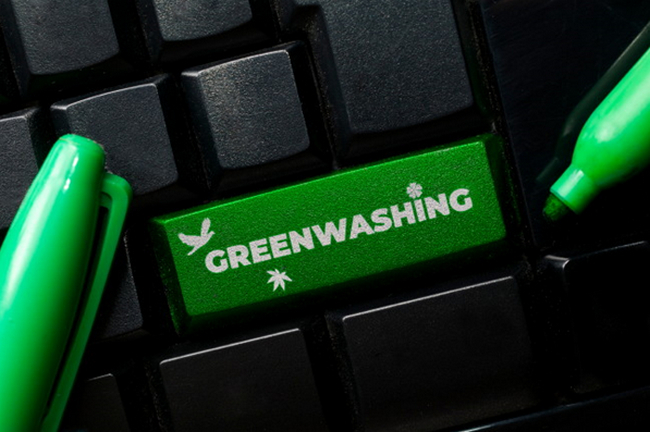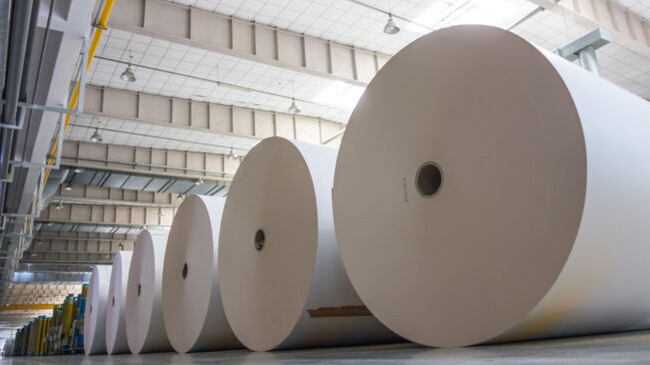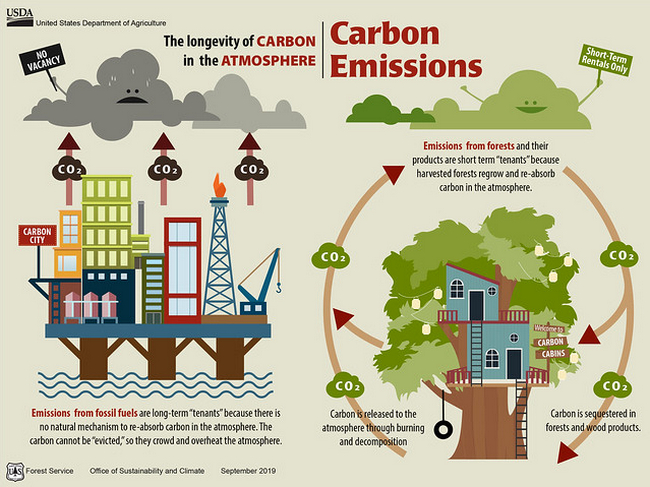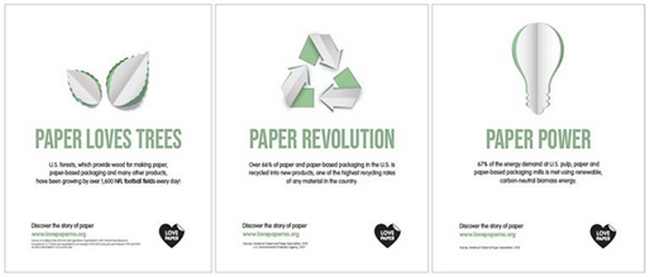Displaying items by tag: two sides
Paper products often carry a label showing that they are certified. But what does that really mean?
By Kathi Rowzie, President, Two Sides North America
Simply put, certification labels are a quick and easy way to tell consumers that the wood fiber in the paper products they buy and use comes from sustainably managed forests. The certification systems behind those labels provide the proof that’s true.
Certification is a voluntary, market-based incentive system that’s implemented through two separate but linked processes: sustainable forest management certification and chain of custody certification.
Forest Management Certification
The United Nations describes sustainable forest management as a “dynamic and evolving concept that aims to maintain and enhance the economic, social and environmental value of forests for the benefit of present and future generations.” Forest certification, which covers the certification of actual forestland, assures that forests are responsibly managed in line with challenging environmental, social and economic requirements.
This certification involves a voluntary process in which an independent, accredited third-party auditor conducts an onsite assessment to determine the quality of forest management against these requirements, typically referred to as forest management standards. These forest management standards are developed in an open, transparent process by a public or private certification organization and are adapted to local context to reflect different forest types and cultural considerations in different regions of the world.
Forest management certification is issued to a forest owner or manager who is assessed to be managing forests according to the standards. Often times, auditors request that land owners make changes in their management practices to better conform to the certification standard before certification is awarded. Landowners and land managers who have completed a successful audit can then make claims their forests are certified to these standards, and sell wood fiber off their land as certified. A summary of certification audit findings is made publicly available in support of these claims.
Forest certification increases the value of forests by building consumer trust, which in turn creates additional demand for forest products like paper and paper-based packaging. Creating additional value and demand for these products is one of the best ways to keep forests standing because it prevents them from being permanently cleared for alternative land uses like urban development.

Chain of Custody Certification
Chain of custody (CoC) certification tracks forest-based products from sustainable forests to the final product. It demonstrates that each step of the supply chain is closely monitored through independent auditing to ensure that unsustainable fiber sources are excluded. Chain of custody certification is available to those who process or trade certified wood products, such as manufacturers, mills, paper merchants, converters, printers, wood dealers, wood yards, wholesalers and brokers.
A CoC system, coupled with a product label identifying the certification system, helps consumers make informed choices by verifying that any paper or paper-based packaging labeled “certified” was produced with wood from a sustainably managed forest.
Forest Certification Standards
While there are dozens of different forest certification standards in use around the world, they share many of the same basic objectives. All demonstrate an additional measure of commitment to sustainable forestry and are effective mechanisms for encouraging and expanding a responsible marketplace for print, paper and paper-based packaging.
The Forest Stewardship Council® (FSC®) and the Programme for the Endorsement of Forest Certification™ (PEFC™) standards account for the vast majority of certified forests and chain-of-custody certificates around the world.
Forest certification programs operate at a national or regional level. An important mission of PEFC™ is to evaluate and endorse national and regional standards, such as the Sustainable Forestry Initiative® (SFI®) standard available in the United States and Canada, and the Canadian Standards Association (CSA) standard.
Over 770 million acres (312 million hectares) are managed in compliance with PEFC’s™ internationally accepted sustainability benchmarks. Three quarters of all certified forests globally are certified to PEFC™ standards. PEFC™ has 55 national members and 50 endorsed national certification systems around the world. 750,000 forest owners are PEFC™ certified globally. Approximately 13,000 PEFC™ chain-of-custody certificates have been issued globally, with 253 in the United States and 176 in Canada.
In North America, the growth of SFI® forest management certification leads all other standards with more than 375 million acres (150 million hectares) certified. Among the SFI® Forest Management Standard’s requirements are measures to protect water quality, biodiversity, wildlife habitat, species at risk, the rights of indigenous peoples, workers’ rights (including gender equity), and forests with exceptional conservation value. SFI® accounts for nearly 35% of global certified forests and 46% of PEFC™ certifications worldwide.
FSC® forest management certification confirms that the forest is being managed in a way that preserves biological diversity and benefits the lives of local people and workers while ensuring it sustains economic viability. Approximately 533 million acres (216 million hectares) globally are certified to the FSC® standard, with 37 million acres (15 million hectares) certified in the United States and 121 million acres (49 million hectares) certified in Canada. Approximately 52,000 FSC® chain of custody certificates have been issued globally, with 2,143 issued in the United States and 508 in Canada.
Global Certification Status
According to UN Food and Agriculture Organization’s most recent Global Forest Resources Assessment (2020), approximately 11% of the world’s forestland – about 1 billion acres (426 million hectares) – is certified, with the majority of certified forestland in North America and Europe. This is net certified area, owing to the fact that some forests are certified to more than one standard. Canada has by far the most with 413 million acres (167 million hectares) certified, followed by Russia with 133 million acres (54.1 million hectares) and the United States with 94 million acres (38 million hectares). These three countries together account for more than 60% of the world’s certified forest area.
What Would Ben Franklin Do?
Mail centre professionals, who already operate in a challenging business environment, are increasingly faced with the task of responding to the popular, but the scientifically flawed narrative that the paper critical to their operations is somehow environmentally unsustainable. If this describes you, then Ben Franklin, father of the Postal Service and first U.S. postmaster general, offers some sage advice: “An investment in knowledge pays the best interest.”
In our increasingly digital world, knowledge – knowing the facts about the unique sustainability of paper – is a potent antidote to the common environmental myths used to justify replacing paper mail with electronic communications: that paper production and use destroys forests, and is a major contributor to climate change, consumes enormous amounts of water and generates excessive amounts of waste.
 Whether you are the leader of an in-plant mailing operation or the CEO of a company delivering mailing solutions to customers around the globe, these “go paperless” conversations will eventually land on your doorstep, if they haven’t already. To demonstrate to your management, investors, customers and other stakeholders that print on paper is a truly sustainable choice, both today and in the future, you need to be armed with the facts.
Whether you are the leader of an in-plant mailing operation or the CEO of a company delivering mailing solutions to customers around the globe, these “go paperless” conversations will eventually land on your doorstep, if they haven’t already. To demonstrate to your management, investors, customers and other stakeholders that print on paper is a truly sustainable choice, both today and in the future, you need to be armed with the facts.
Fortunately, there is an arsenal of data to help you make the case for the sustainability paper.
Myth: Using paper causes deforestation and destroys forests
In the United States, trees to make paper are grown, harvested and regrown using sustainable forest management practices that perpetuate infinitely renewable forestlands. While the paper industry was producing products that enrich the lives of consumers, the net forestland area in the United States actually increased 18 million acres between 1990 and 2020, according to the latest Global Forest Resources Assessment by the UN Food and Agriculture Organization (FAO). That’s an area equivalent to 1,200 NFL football fields every day!
The U.S. Forest Service (USFS) reports that less than 2% of U.S. forestland is harvested each year, compared with 3% that is disturbed annually by natural causes like fire, insects and disease, and most of this 2% of harvested wood is used for non-paper purposes.
Contrary to the myth that paper destroys forests, the production of paper products is a powerful economic engine and driving force in keeping U.S. lands forested. By providing a dependable market for responsibly grown fiber, the paper industry encourages landowners to manage their forestland instead of selling it for development or other non-forest uses. More than half (58%) of the forestland in the U.S. is privately owned and managed, mostly by millions of small landowners, and they are under no obligation to keep their lands forested. Without the economic incentive provided by the paper industry, untold millions of acres of forestland would likely have been lost permanently to commercial land development – converted to building projects, strip malls or parking lots.
So, is deforestation in the U.S. a real concern? Yes, but using paper is not the cause. The FAO defines deforestation as the permanent loss of forestland. In fact, the definition specifically excludes logging for the production of paper and other products because trees in these “working forests” are expected to grow back, either through natural regeneration or sustainable forestry practices. In the United States, the primary cause of forest loss is rapidly expanding urban development, according to the USFS.
Myth: Paper is a major cause of greenhouse gas emissions that contribute to climate change
According to the most recent data available from the U.S. Environmental Protection Agency (EPA), the pulp and paper industry is responsible for only 0.5% of total annual U.S. GHG emissions. These very low emissions are due to decades of energy efficiency and process improvements at U.S paper mills, and to the fact that the U.S. paper industry generates two-thirds of the energy to manufacture its products using renewable, carbon-neutral fuels, primarily biomass.
According to the EPA, the paper industry produces more carbon-neutral bioenergy than any other industrial sector, using mostly wood-based leftovers from the papermaking process. This bioenergy use prevents around 181 million metric tons of CO2 from entering the atmosphere each year – roughly equivalent to removing 35 million cars from the road.
Myth: Paper manufacturing consumes enormous amounts of water
While it’s true that the paper industry uses large amounts of water to manufacture its products, most of that water is not consumed in the manufacturing process, according to the National Council for Air and Stream Improvement (NCASI). NCASI reports that water used in the papermaking process is recycled up to 10 times in a typical paper mill, and then nearly 90% of that water is cleaned to meet federal and state clean water standards before it is returned to its source. Most of the remaining water evaporates back into the environment, with around 1% retained in the manufactured paper.
Myth: Paper generates excessive amounts of waste
When it comes to circularity, the idea that products should be reused or recycled, paper has all other materials beat hands down. Thanks to the paper industry’s voluntary, multi-billion dollar investments in commercial paper recovery infrastructure and to the commitment of millions of organizations and individual Americans who choose to recycle every day, U.S. paper recycling has nearly doubled over the past 20 years. At 68%, the EPA reports that the U.S. paper recovery rate is higher than any other material in the country, including plastics (9%), glass (25%) and metals (34%). The recovery rate of corrugated cardboard is 89%.
Myth: Electronic communication is better for the environment than paper
The miniaturization of digital devices and the “invisibility” of the infrastructures needed to support them leads many to underestimate the environmental footprint of digital technology. This phenomenon is reinforced by the widespread availability of services on the “cloud,” which makes the physical reality of use and the direct environmental impacts of digital technology all the more imperceptible.
Any organization considering a paperless strategy for sustainability reasons must recognize that digital technology places enormous and growing burdens on the environment. Here too, the proof is in the data.
First, consider the environmentally intensive drilling and mining required to extract source materials from the earth. Computers, tablets and other electronic devices are made with non-renewable resources – fossil fuels, chemicals, precious metals, rare earth minerals and toxic minerals like lead, mercury and arsenic that are dangerous when released into the environment. Cisco, the worldwide leader in internet technology, projects that North America will have 5 billion networked devices in 2023, up from 3 billion in 2018 – a 40% increase. Cisco also projects that the average per capita number of devices and connections in the U.S. will reach 13.6 in 2023, far higher than the estimated 2023 global average of 3.6 devices per person.
Electronic devices and the massive server farms that support them are powered using mostly fossil fuels (only 17% of U.S. energy is generated from renewable sources). The Shift Project, a think tank focused on the shift to a post-carbon economy, reports that energy consumption for digital devices is increasing 9% each year, and the share of digital technologies in global greenhouse gas emissions increased by half between 2013 and 2019, from 2.5% to 3.7%. A 2015 study (Andrae and Elder) estimates that the information technology sector could use as much as 51% of global electricity and contribute 23% of global greenhouse gas emissions by 2030.
And according to the most recent Global E-Waste Monitor report, electronic devices create nearly 7 million metric tons of e-waste annually in the U.S., and only 15% of that e-waste is recycled. Most of the remaining e-waste is either burned, landfilled or dumped.
Paper: A responsible environmental choice
Digital technology has become an essential part of our everyday lives and is likely making beneficial contributions to your mailing operations, but it also has wide-ranging environmental impacts that continue to grow. While all manufacturing processes have an environmental footprint, the fact that paper is made with an infinitely renewable resource, is manufactured using mostly renewable, carbon-neutral energy, consumes very little water, is recyclable and is recycled more than any other material, makes a strong case for its continued use.
Two Sides North America (twosidesna.org) is a non-profit organization whose members span the entire print, paper, paper-based packaging and mail value chain. Funded entirely by membership dues, Two Sides is the only industry organization that directly challenges unsubstantiated environmental claims about paper made by corporations, the media, government agencies and others. Two Sides also supports its members with factual, science-based resources to supplement their own sustainability efforts. Learn how to join at twosidesna.org/become-a-member/.
Two Sides Global Anti-Greenwashing Campaign Momentum Continues as More Companies Remove Anti-paper Environmental Claims
As banks, utilities, telecom companies and government agencies face mounting economic uncertainties, many of these services providers are looking to cut costs by encouraging their customers to switch from paper to digital communications. But all too often, these cost-cutting appeals are cloaked in unsubstantiated and misleading environmental marketing claims that suggest going paperless is “green,” “saves trees” or “is better for the environment.”
“These greenwashing claims not only fail to comply with established environmental marketing standards, but they also damage consumer perceptions of paper’s environmental sustainability,” says Two Sides North America President Kathi Rowzie. “And that’s a threat to the economic security of millions of people in the United States and Canada whose livelihoods depend on the paper, print and mailing sector.”
North America’s leading corporations and other service providers influence millions of consumers every day with their anti-paper greenwashing claims, leading many to believe that the use of paper is destroying forests and is bad for the environment. For example, a 2021 Two Sides survey of U.S. consumers showed that 60% believe that U.S. forests are shrinking, when in fact, U.S. net forest area increased by 18 million acres over the past 30 years – the equivalent of 1,200 NFL football fields every day – according to the U.N. Food and Agriculture Organization (FAO) Global Forest Resources Assessment. The UN FAO reports that Canada’s net forest area remained stable at around 857 million acres during the same period.
“Paper is one of the few products on earth that already has an environmentally sustainable, circular life cycle,” Rowzie says. “North American paper is made from an infinitely renewable natural resource – trees grown, harvested and regrown in sustainably managed forests. It’s manufactured using mostly renewable, carbon neutral bioenergy in a process that uses water, but in reality consumes very little of it. And paper products are recycled more than any other material. But many consumers believe paper is bad for the environment because their service providers are telling them so. Two Sides is working hard to change that.”
 Since 2010, Two Sides’ fact-driven campaign has persuaded more than 880 organizations globally, including 159 in North America, to remove unsubstantiated environmental claims about paper from their marketing communications.
Since 2010, Two Sides’ fact-driven campaign has persuaded more than 880 organizations globally, including 159 in North America, to remove unsubstantiated environmental claims about paper from their marketing communications.
Two Sides challenges greenwashing companies and other organizations in a non-confrontational way, educating CEOs and other senior management with facts from credible, third-party sources that clearly demonstrate the unique sustainability characteristics of paper products and the solid and continually improving environmental record of the North American paper industry. Because North America’s leading corporations and other service providers have such an expansive reach, Two Sides anti-greenwashing efforts to date have had an enormous impact, with unsubstantiated “go paperless” environmental messages removed from literally billions of customer communications.
“But there’s much more work to do as companies continue to distort the paper industry’s great environmental record and threaten paper, print and mail volumes with opportunistic greenwashing claims,” Rowzie says. “This is why the Anti-Greenwashing Campaign continues to be a top priority for Two Sides.”
Across North and South America, Europe, South Africa, Australia and New Zealand, Two Sides has challenged more than 1,900 organizations that have made unsubstantiated environmental claims about paper and continues to pursue those whose use greenwashing claims to mask their cost-cutting efforts.
“We are grateful for the cooperation of the hundreds of organizations that have changed or eliminated greenwashing claims from their messaging, and we are also thankful for the many industry stakeholders and members of the public who send Two Sides examples of greenwashing,” Rowzie concludes.
To learn more about Two Sides North America and its Anti-Greenwashing Campaign, please visit www.twosidesna.org.
About Two Sides
Two Sides is a global, member-funded non-profit organization dedicated to promoting the uniquely sustainable attributes of print, paper and paper-based packaging. Two Sides’ members span the entire print, paper and paper-based packaging value chain, including forestry, pulp, paper, packaging, inks and chemicals, finishing, publishing, printing, envelopes and mail operators. For more information, visit www.twosidesna.org.
It’s True: Paper Products Are Not a Major Contributor to Climate Change. Here’s Why…
If you’ve been following Two Sides or other authoritative sources, you know that the paper products you use do not contribute in any major way to climate change. Why? Because most of the energy used to manufacture them is generated using renewable, carbon neutral biomass. But what does this really mean?
The life cycle of paper, like that of any other widely manufactured and used product, does involve the emission of carbon – the key element in most greenhouse gases. However, with paper, there’s a critical difference.
To put it simply, the carbon released from burning biomass does not contribute to climate change, while the carbon released from fossil fuel does.

Biomass, also called biogenic carbon, is carbon that is absorbed from the atmosphere and stored in trees and other vegetation though photosynthesis. When that biomass later decays in the forest or is burned – either in forest fires or as fuel in a paper mill – its carbon returns back to the atmosphere in an endless natural loop that continuously recycles the same carbon atoms (called the “terrestrial carbon cycle”). Consequently, no new carbon is added to the environment.
On the other hand, the carbon from fossil fuels originates from deposits that have been stored in the earth for tens of millions of years. When coal and oil are extracted from those deposits and burned for energy, “new” carbon from outside the terrestrial carbon cycle is added to the atmosphere. The result is a net increase in greenhouse gases. And that is what’s warming the climate.
In an interesting take on the difference between the two sources of carbon, the U.S. Department of Agriculture compares them to the relationship between landlords and tenants. Biogenic carbon emissions are like tenants who “stay only the duration of their short-term leases, and politely leave over time as the regenerating forest calls them back,” while fossil fuels are “carbon tenants who squat permanently in our home and change the balance we previously had.”
Think about it. Humans have been burning biomass – especially wood – as a primary source of heat for millennia. Yet, as paleoclimatologists have found, not until the industrial revolution, with its massive reliance on fossil fuels, have greenhouse gases begun to increase so dramatically in the atmosphere. Before the widespread use of fossil fuels, the maximum concentration of carbon dioxide equivalent (CO2-e) held steady at a maximum of around 280 parts per million (ppm). Since then, however, that concentration has climbed to over 500 ppm, and it continues to increase.

The work of the national and international agencies and bodies directly responsible for the study, regulation and accounting of greenhouse gases is based on the fundamental finding that fossil fuel carbon, not biogenic carbon, is the problem. Among these organizations are the Intergovernmental Panel on Climate Change (IPCC), the International Energy Agency, the U.S. EPA and the U.S. Department of Energy, to name a few.
It follows then, that a biomass-based industry like papermaking, which uses and emits mostly biogenic carbon, is not a major contributor to climate change. In fact, that’s what the numbers show. The U.S. Environmental Protection Agency (EPA) and Natural Resources Canada report that the pulp and paper industry in their respective countries is responsible for only 0.5% and 1.2% of total annual CO2-e emissions. The IPCC states that over the course of a year, the CO2 emissions from the combustion/oxidation/decay of biomass are balanced by carbon uptake prior to harvest, so the net emission is zero. IPCC also states that when used to displace fossil fuels, wood-based fuels can provide sustained carbon benefits and constitute a large [carbon] mitigation option.
It is true that over the life cycle of paper, some carbon is released as greenhouse gases other than CO2. For example, paper that decomposes in landfills releases methane. However, the more paper products are recycled, the less methane is emitted, and paper is recycled more than any other material in the United States. By reducing the amount of paper products going to landfills through recycling, U.S. greenhouse gases emissions were lowered by 155 million metric tons of CO2-e in 2018 – the equivalent of taking over 33 million cars off the road for an entire year, this according to the U.S. EPA.
For more information, download the updated Two Sides Fact Sheet on Paper, Renewable Energy and Carbon Footprint here.
by Kathi Rowzie, President, Two Sides North America
Member Spotlight: West World Paper

Headquartered in Coquitlam, BC, West World Paper (WWP) is a merchant that services the commercial print market in Western Canada. The company offers a wide range of fine paper products, office papers, envelopes, wide format media, janitorial and industrial products. In addition, WWP has an internal converting department that produces engineering/CAD rolls, films, kraft paper and newsprint rolls. From its 30,000-square-foot headquarters and another 12,000-square-foot facility in Calgary, AB, the company manages more than 2,000 products and operates its own fleet of trucks, making distribution to customers in the region fast and efficient.
West World Paper has built a strong reputation not only for providing high quality products, but also for its commitment to environmental sustainability and social responsibility. The company assures that the pulp in all products it buys is sourced from sustainably managed forests. They have an extensive internal recycling program as well as a recycling program for customers. And they are big supporters of other local businesses and charities. WWP Director Shawn Leach says Two Sides membership is a perfect complement to the company’s sustainability efforts.
“Two Sides is a tremendous advocate for our industry, and West World Paper is proud to be a member,” Leach says. “There are so many misconceptions about our industry and our products, and Two Sides effectively busts those myths by highlighting the many studies and facts from trusted third-party sources in an easy to understand format. And being a non-profit organization only adds to the credibility of their messaging and materials, which West World Paper uses regularly to help educate our customers and consumers,” he says.
West World Paper’s extensive internal recycling program recovers all paper, corrugated, wood and plastic used in its facilities, which is then sent to a local recycling company. The wide format paper rolls that WWP converts for the reprographic industry include paper cores and plastic caps. When the company delivers new rolls to a customer, they pick up the cores and caps from the empty rolls and reuse them in the converting process, preventing them from going to the landfill.
“In addition to our environmental commitment, we’re also big supporters of our local economy,” WWP Director Kevin Burden explains. “We make every decision with our local community top of mind. We use a local bank, local legal and accounting services, local graphic designers and of course, local printers. We want people to understand that when they support West World Paper, they are supporting our local community.”
WWP also supports the local community with its charitable contributions. One of the company’s key efforts is its participation in the Starfish Backpack Program, an effort supported by local Rotary Clubs across British Columbia which provides weekend meals to families in need. Many weeks throughout the year, WWP employees fill backpacks with meals and snacks and deliver them to a local school for students to take home for the weekend. The students return the empty backpacks to the school, and the volunteers pick them up to be refilled.
“We have a highly experienced, dedicated team that takes a great deal of pride in going above and beyond for our customers and our community,” Burden says. Giving back is just one of the many ways they help transform West World Paper’s sustainability commitment into action.”
For more information about West World Paper, visit www.westworldpaper.com.
Is Going Paperless Really Better for the Environment?
Many banks, utilities, telecoms and other service providers continue to encourage (and sometimes force) their customers to switch from paper to electronic communications, using claims that electronic communication is “greener,” “saves trees” or “protects the planet” as justification. One can only conclude that the CEOs of these companies are either 1) misinformed about the inherent sustainability of print and paper, the rapidly expanding environmental footprint of digital communication or both, 2) trusting marketing teams who don’t bother to validate environmental claims or 3) seeking to save costs by ignoring established environmental marketing rules from the U.S. FTC and Canadian Standards Association that say marketers “should not make broad, unqualified environmental benefit claims like “green” and that “claims should be clear, prominent and specific.”
Growth of electronic devices and e-waste
There’s no arguing that the use of electronic devices has exploded over the last decade. According to a 2019 study by the Pew Research Center, the vast majority of Americans (81%) now own smartphones, up from just 35% in 2011. Nearly three-quarters of U.S. adults now own desktop or laptop computers, and roughly half now own tablets and e-readers. This boom has resulted in many advances that make our lives more efficient, productive and enjoyable. But it has also brought with it serious and increasing environmental, health and economic consequences.
According to the recently released Global E-waste Monitor (GEM) 2020, a record 53.6 million metric tons (Mt) of electronic waste was generated in 2019, up 21% in just five years. For perspective, last year’s e-waste weighed as much as 350 cruise ships the size of the Queen Mary 2, enough to form a line 76 miles long. The GEM describes e-waste as discarded products with a battery or plug. Small electronic equipment, screens and monitors, small IT and telecommunication equipment comprised more than half of global e-waste last year. The U.S. and Canada collectively generated 7.7 Mt of electronic waste in 2019. That’s 46 lbs. per person, and nearly three times the worldwide per capita generation of 16 lbs.

The report also predicts global e-waste, will reach 74 Mt by 2030, almost a doubling of e-waste in just 16 years. This makes e-waste the world’s fastest-growing waste stream, fueled by higher consumption rates of electric and electronic devices, short device life cycles and few options for repair. Many people now see devices and appliances as ultimately disposable, simply discarding them when it’s time for an upgrade. Others may hold on to them, but are unable to find a cost-effective way to repair them.
Little e-waste is recycled
The GEM found that only 17.4% of e-waste was collected and recycled globally in 2019, with only 15% of e-waste in North America recycled. Most e-waste was either dumped or burned rather than being collected for recycling and reuse.
Numerous toxic and hazardous substances are found in electronic equipment and pose severe risk to the environment and human health when not handled in an environmentally sound manner. Recent research cited in the GEM found that unregulated e-waste is associated with increasing numbers of adverse health effects, from birth defects and altered neurodevelopment to DNA damage, adverse cardiovascular and respiratory effects and cancer.
E-waste also represents a huge economic loss. When electronic devices are simply thrown away, high-value, recoverable materials such as iron, copper and gold are thrown away with them. “If we cannot recycle electronic waste, we’re not taking back materials into the loop, which means we have to extract new raw materials,” says Vanessa Forti, the lead author of the GEM. It’s estimated that the value of raw materials in all global e-waste generated in 2019 equaled a staggering $57 billion US, more than the gross domestic product of most countries.
Electronic communication, energy consumption and climate change
The miniaturization of equipment and the “invisibility” of the infrastructures used leads many to underestimate the environmental footprint of digital technology. This phenomenon is reinforced by the widespread availability of services on the “cloud,” which makes the physical reality of use all the more imperceptible and leads to underestimating the direct environmental impacts of digital technology.
By 2023, global tech giant Cisco estimates that North America will have 345 million internet users (up from 328 million in 2018), and 5 billion networked devices/connections (up from 3 billion in 2018). The U.S. Department of Energy reports that U.S. data centers consumed an estimated 70 billion kilowatt hours (kWh) in 2014, representing about 1.8% of total U.S. electricity consumption. Based on current trend estimates, U.S. data centers are projected to consume approximately 73 billion kWh in 2020. This energy consumption does not include the energy required to build, power or recharge the devices.
According to The Shift Project, a carbon transition think tank, the energy consumption required for digital technologies is increasing 9% each year and the share of digital technology in global greenhouse gas (GHG) emissions could double to 8% by 2025. The U.S. National Renewable Energy Laboratory analyzed 113 information technology companies in 2014 and found that only 14% of the energy consumed was from renewable sources.
The contrasts between electronic and paper communications are well-defined
The magnitude of the negative impacts resulting from the use of electronic communication should be cause enough for companies to abandon their unverifiable greenwashing claims that going digital is better for the environment, but the comparison with paper-based communication should seal the deal for those that are committed to responsible marketing practices.
- Paper is made from a renewable resource – trees from sustainably managed forests.
- With a recovery rate of 66% in the U.S. and 70% in Canada, paper is recycled more than any other commodity in North America.
- Most of the energy used to manufacture paper in North America comes from carbon-neutral biomass and other renewable sources.
- The U.S. pulp and paper industry emitted 35.7 Mt of GHG emissions in 2018, which was only 1.2% of total direct U.S. emissions.
- More than 90% of the water used to manufacture paper in North America is cleaned and returned to the source. Most of the remainder evaporates or remains in paper products.
- The North American paper industry has shown continuous environmental performance improvement which is well documented.
Since its inception, Two Sides has been working to end corporate greenwashing of print and paper. For more information about Two Sides’ Anti-greenwash Campaign, click here.
For more facts on electronic communication and other paper sustainability topics, click here.
Two Sides North America Launches "Love Paper" Campaign
Website and ads feature sustainability facts about print and paper products related to forestry, recycling and renewable energy use in the U.S. and Canada
Two Sides North America has just announced the launch of Love Paper, a new campaign designed to raise consumer awareness of the unique and inherently sustainable characteristics of print, paper and paper-based packaging. The centerpiece of the campaign is a consumer-friendly website, lovepaperna.org, where the click of a mouse reveals surprising facts about how print and paper products contribute to a sustainable future for us all.
“As consumers become increasingly concerned about the environmental impacts of the publications they read, the products they buy and the packaging those products come in, they need factual, science-based information to make informed purchasing decisions,” says Two Sides North America President Phil Riebel. “But all too often, they have little more than unsubstantiated marketing claims like ‘go green, go paperless’ or ‘going paperless saves trees’ to guide them. We created the Love Paper campaign to make it easy for anyone to get verifiable facts about the sustainability of print and paper products from a wide variety of trusted sources.”

Publisher support
A key element of the Love Paper campaign is a series of print ads that promote the sustainability of print and paper. The ads, which focus on the sustainable forestry, recycling and renewable energy advantages of paper, are available to newspaper and magazine publishers free of charge. Editor & Publisher (E&P) magazine, the authoritative journal covering all aspects of the newspaper industry, is among the ad campaign’s most enthusiastic supporters.
“The newspaper industry and our suppliers are very focused on environmental sustainability, so supporting the Love Paper campaign is a natural fit for us,” says E&P Publisher Mike Blinder. “We especially like the ‘Paper Revolution’ ad on recycling because newspaper recycling is such a big part of the American recycling success story. Nearly 70% of old newspapers are recycled into new newsprint, boxboard and other products. The Love Paper ads help us share this great story with our readers.”
The full color ads are available in full page, half page (horizontal and vertical) and quarter page sizes. Publishers interested in running the ads can go to the “For Publishers” page on the www.lovepaperna.org website or email Two Sides North America at This email address is being protected from spambots. You need JavaScript enabled to view it..
Consumers Underestimate the Sustainability of Print and Paper Products
By their very nature, print and paper products are an important part of a circular economy where resources are used as productively and efficiently as possible. They are made with renewable raw materials, are recyclable and in North America are manufactured using mostly renewable, carbon-neutral energy, making them an environmentally sound choice for reading materials, communications and packaging solutions. Yet many North American consumers significantly underestimate how sustainable print and paper products truly are.
For example, a 2019 survey commissioned by Two Sides found that 58% of consumers believe U.S. forests are shrinking. In fact, the U.N. Food and Agriculture Organization estimates these forests, which supply the fresh wood fiber used by the U.S. pulp and paper industry, grew by a net area equivalent to more than 1,600 NFL football fields per day between 1990 and 2015. In Canada, only 21% of consumers think the recycling rate for paper and paper-based packaging exceeds 60%. In reality, the Canadian recycling rate is among the highest in the world at 70% according to the Forest Products Association of Canada.
“Our surveys also show that 68% of U.S. consumers believe print is the most enjoyable way to read books and 65% prefer reading printed magazines, with Canadian consumer preferences closely matching those of Americans,” Riebel says. “On the packaging side, our data also show that more than half of U.S. consumers surveyed are actively taking steps to reduce their use of plastic packaging as evidence of harm caused by plastic litter in the oceans continues to grow. The Love Paper campaign provides credible, fact-based information on why print and paper products are an environmentally responsible choice.”
About Two Sides
Two Sides North America, Inc. is an independent, non-profit organization that promotes the sustainability of the Graphic Communications and Paper-based Packaging value chain and dispels common environmental misperceptions about print and paper products. We are part of the Two Sides global network which includes more than 600 member companies across North America, South America, Europe, Australia and South Africa. Our member companies span the Graphic Communications and Paper-based Packaging value chain, including forestry, pulp, paper, paper-based packaging, chemicals and inks, pre-press, press, finishing, printing, publishing, envelopes and postal operations. For more information about Two Sides North America, visit us at www.twosidesna.org
New Product Category Rules Issued for Paper Products
The American Forest & Paper Association (AF&PA), in collaboration with the Forest Products Association of Canada (FPAC) and FPInnovations issued Product Category Rules (PCR) for Market Pulp, Paper and Paperboard, Containerboard and Tissue products manufactured in North America.
 The PCR provides rules and requirements for conducting paper product life cycle assessment (LCA) reports as well as developing Type III Environmental Product Declarations that communicate the environmental footprint of products to customers. The PCR development process included the participation of a broad stakeholder group including manufacturers, trade associations, government agencies, non-government organizations, retail representatives, independent parties, academia and other Environmental Product Declarations program operators.
The PCR provides rules and requirements for conducting paper product life cycle assessment (LCA) reports as well as developing Type III Environmental Product Declarations that communicate the environmental footprint of products to customers. The PCR development process included the participation of a broad stakeholder group including manufacturers, trade associations, government agencies, non-government organizations, retail representatives, independent parties, academia and other Environmental Product Declarations program operators.
“This PCR has been approved by an independent peer review panel of recognized LCA experts,” said Debbie Steckel, Executive Director of the American Center for Life Cycle Assessment. “It conforms to the requirements of ISO International Standards, providing consistent and transparent environmental evaluation standards with the highest degree of credibility.”
Lal Mahalle, project leader for FPInnovations, said, “Paper buyers can feel confident that product sustainability documentation using our PCR guidance covers the environmental impact categories that are published in recognized scientific literature and are most relevant to pulp and paper products made in North America”.
The PCR is available on the FPInnovations website:
PCR for North American Pulp Market Pulp, Paper and Paperboard Products, Tissue and Containerboard
The American Forest & Paper Association (AF&PA) serves to advance a sustainable U.S. pulp, paper, packaging, tissue and wood products manufacturing industry through fact-based public policy and marketplace advocacy. AF&PA member companies make products essential for everyday life from renewable and recyclable resources and are committed to continuous improvement through the industry’s sustainability initiative - Better Practices, Better Planet 2020. The forest products industry accounts for approximately four percent of the total U.S. manufacturing GDP, manufactures over $200 billion in products annually, and employs approximately 900,000 men and women. The industry meets a payroll of approximately $50 billion annually and is among the top 10 manufacturing sector employers in 45 states. Visit AF&PA online at www.afandpa.org or follow us on Twitter @ForestandPaper
Celebrate the Sustainability of Paper from Well Managed U.S. Forests
Each year since 1960, the third week in October has been proclaimed National Forest Products Week in the U.S. It is a time to recognize the essential role that forests play in the country’s history, culture, environment and economy. Our forests are a source of clean air and water, are home to a diversity of fish and wildlife, a place to enjoy, provide us with many products made from wood and are a source of employment for people who work in and manage the forests.
 From houses to paper to packaging to fuel to furniture to railways, wood products are an irreplaceable part of our daily lives. But those are just the traditional uses of forest products! What about all the surprising everyday items that contain products from wood? Wood cellulose, released when wood is processed into pulp, is used to make ping pong balls, sports helmets, nail polish and synthetic fibres, which are made into clothes and towels – just to name a few.
From houses to paper to packaging to fuel to furniture to railways, wood products are an irreplaceable part of our daily lives. But those are just the traditional uses of forest products! What about all the surprising everyday items that contain products from wood? Wood cellulose, released when wood is processed into pulp, is used to make ping pong balls, sports helmets, nail polish and synthetic fibres, which are made into clothes and towels – just to name a few.
The forest products industry directly employed over 900,000 people in 2017 in the U.S. and provided 2.4 million supporting jobs in 45 states across the country. The industry generates 4% of the total U.S. manufacturing GDP and wood products are a globally-traded commodity that supports U.S. economic growth. The U.S. is one of the world's most diverse exporters of sustainable forest products.
One of the great qualities of forest products made in North America, is that they come from a renewable and sustainable resource: trees! And not only are wood products durable and energy efficient; healthy, growing forests are an important part of our culture as well as playing a key role in absorbing carbon dioxide, releasing oxygen and storing carbon over time. For more information on the renewable energy use and carbon footprint of making paper see this Two Sides Fact Sheet.
Our forest products, including pulp and paper, are being produced from sustainable forestry in the U. S. where forest area increased from over 302 million ha in 1990 to almost 309 million ha in 2010 and about 310 million ha in 2015, a total increase of almost 8 million ha (UNFAO, 2016).
So, look around you this week and count up the many ways that forest products are important in your life.
Two Sides Global Anti-greenwash Campaign: 278 leading companies remove misleading ‘go green’ claims
Two Sides, the global initiative to promote the sustainability of print and paper, reports a 61% success rate in removing misleading environmental claims made by some of the world’s largest corporations as they seek to replace paper-based communications with lower cost electronic alternatives.
Two Sides research into more than 600 of the world’s leading corporations, including banks, utilities, telecoms and insurance providers, has shown that a total of 460 of those companies have been using misleading and unsubstantiated environmental statements, despite specific advertising legislation to protect consumers in many countries. To date, 278 of those companies have removed such statements as a result of ongoing engagement by Two Sides.
 “We’re really pleased that Two Sides is having such a significant effect on some of the world’s largest and most influential organizations. But there is no room for complacency, and there is still a great deal of work to do with the remaining companies that continue to mislead their customers,” says Martyn Eustace, Chairman of Two Sides UK.
“We’re really pleased that Two Sides is having such a significant effect on some of the world’s largest and most influential organizations. But there is no room for complacency, and there is still a great deal of work to do with the remaining companies that continue to mislead their customers,” says Martyn Eustace, Chairman of Two Sides UK.
Internationally, Two Sides teams are continuing to tackle greenwash in their respective countries, and this has yielded positive results.
North America
Phil Riebel, President of Two Sides North America, comments: “Over 88 major corporations, including many of the Fortune 500, have now changed or removed misleading environmental claims about print and paper to comply with country-specific environmental marketing guidelines. Our discussions with Chief Marketing Officers, Chief Sustainability Officers and others, have been very productive and we are pleased with the collaboration of North America’s leading organizations. Thanks to an overall better understanding of the unique sustainable features of paper products, “go green - go paperless” and “save a tree” claims are gradually disappearing from the marketplace.”
Australia & New Zealand
Kellie Northwood, Executive Director, Two Sides Australia and New Zealand, comments, “It is our responsibility as an industry, but also as part of broader environmental education, to challenge misinformation about the impact of communication channels. Greenwashing is a threat to our industry and we work very hard to ensure companies making the wrong claims correct their communications. Of the companies we have contacted in Australia, 73% have altered their anti-print messaging, and the remaining we continue to engage with.”
Brazil
“This year Two Sides Brazil has chosen the fight against greenwashing as a number one priority,” says Fabio Arruda Mortara, Country Manager for Two Sides in Brazil. “Reaching an agreement with the public sector, towards the withdrawal of several instances of misleading content on websites or public declarations, was probably our best achievement in 2017. Brazil has just become the second largest pulp producer in the world, showing the importance for widespread environmental education in such a large country. Everyone in the world has the right to know that print and paper are not hostile to the environment and add immense value to our civilization.”
South Africa
Deon Joubert, Executive Director, Two Sides South Africa, adds: “We continue to engage with corporates and government institutions regarding their environmental messaging to their customers and citizens. There remains a concern that conventional wisdom linking the use of paper to the destruction of forests remains prevalent and unchallenged. Not only are plantation trees grown to be harvested, just like any crop, these plantations provide commercial and surprisingly good environmental benefits to our world. In addition, in a recent Toluna research project conducted in South Africa, 92% of consumers want to be able to choose how they receive communication from corporations and government.”
Colombia
“During the first year of the campaign, we collaborated with the Government to remove any mention of ‘zero paper’ from their National Development Plan for the next four years,” says Isabel Riveros, Executive Director, Two Sides in Colombia. “However, the challenge continues. We must contact every company that is using greenwash, and make them understand that the process of paper production can be a sustainable one.”
France
“Our research shows clearly that consumer’s perception on the sustainability of print and paper is negatively influenced by marketing of digitalisation,” says Hadrien Cottin, Two Sides France. “We will continue to engage organizations with the facts how paper based communications are a sustainable choice.”
UK
Jonathan Tame, Country Manager, Two Sides UK, adds, “We have an active campaign to research and remove greenwash in the UK, with a very encouraging response. 83% of all companies we have engaged have agreed to remove misleading messages, and in many cases, we have helped organizations amend their marketing communication guidelines.”
Martyn Eustace concludes: “Consumers should not be misled and encouraged to go ‘paperless’ through the use of misleading ‘green’ marketing. The environmental and social benefits of paper are being overlooked by these false and damaging messages. Based on our consumer surveys, the majority of consumers recognize that paper is a renewable and recyclable product that, if responsibly produced and used, can be a sustainable way to communicate – while also providing real benefits of tangibility, authenticity and authority that can be lacking in electronic communications. Forests are a precious and growing resource, and the forest and paper industries are some of their most important guardians.”
About Two Sides
Two Sides is a global initiative by companies from the Graphic Communications Industry including Forestry, Pulp, Paper, Inks and Chemicals, Pre-Press, Press, Finishing, Publishing, Printing, Envelopes and Postal Operators. Our common goal is to promote the sustainability of the Graphic Communications Industry and dispel common environmental misconceptions by providing users with verifiable information on why Print and Paper is an attractive, practical and sustainable communications medium. For more information please visit www.twosidesna.org
